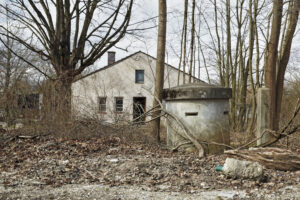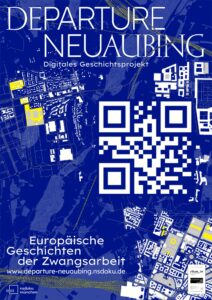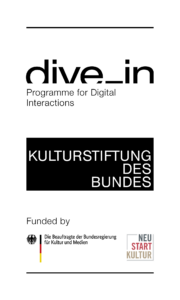From a historic site to a digital space
“Departure Neuaubing” is designed to accompany the development of a new memorial site in the Munich district of Neuaubing. Eight barracks of a former forced labor camp built by the Reichsbahn (German Railways) in 1942 still stand at Ehrenbürgstraße 9 today. In the period from then until the war ended in 1945 up to 1,000 forced laborers were housed here. They had been deported from many different European countries and forced to work in the nearby Reichsbahn Maintenance Workshops (RAW). The majority of them were from the Soviet Union, Poland, and Italy. A new exhibition and memorial site devoted to the history of forced labor in Nazi Germany is currently being realized at this historic location and is scheduled to open in 2025.
Taking a multi-faceted approach to history, the interactive web app “Departure Neuaubing” invites users to find out more about the history of forced labor, make their own contributions and engage in a dialogue about what the past means today.
“Departure Neuaubing” considers this history in an international context and conceptualizes various narrative and artistic formats to address Nazi-era forced labor and its present-day impact and continuities. By combining artistic approaches with historical knowledge crucial questions are being raised: questions about how we treat history—about suppression and denial, belated remembrance, and the meaning of historical experience in today’s Europe.

Participatory remembrance
Artists, game designers, journalists, and media educators approached the topic on many different levels, using a variety of media. Their common objective was to relate historical knowledge to present-day realities. New projects developed specifically for the app take us to Rotterdam, to Yevmynka in Ukraine, and to villages and towns in northern Italy as well as to places in and around Munich.
The app is designed to allow you to post your own photos and texts in the digital archive of “Departure Neuaubing” and to discuss the many different aspects of forced labor. Some questions you might ask yourselves are: How do I imagine a memorial site of the future? How can history be made visible and palpable? What stories do testimony, objects, and documents tell? What is my place in this history? Who determines the historical narrative and what are their interests in doing so? What is required to create a memorial site? How can memory be perpetuated? Where is history visible in the city? What is the connection between labor and migration today?
These are just some of the many questions we would like to explore with you. “Departure Neuaubing” is a work in progress that will evolve through participation and interaction. As such, it encourages people to view remembrance as an active process. As well as simply telling us what happened, the project sharpens our awareness of history as something still present and offers space for reflection and discussion.
“Departure Neuaubing” is a project involving artists and educators that tells the story of Nazi forced labor by digital means and from multiple perspectives: as personal experiences but also as collective histories, and as national narratives that also embrace the global context.
Millions of people from many European countries were deported and exploited by the Nazis. Only a small number of them have received any kind of recognition and even if they have, it has been extremely belated. At the same time, structures from the Nazi system of forced labor were preserved in Germany that allowed those who had profited from the Nazi regime to continue enriching themselves. The continuing use of this material basis also contributed to Germany’s economic upswing in the postwar period. Taking these complex historical circumstances as its starting point, “Departure Neubing” draws attention to how the past has been treated in postwar Europe to this day.

The first six projects were realized together with the artists Fabian Bechtle and Leon Kahane, Sima Dehgani, Hadas Tapouchi and Franz Wanner, the game designers of Paintbucket Games, the cartoonist Barbara Yelin, the Süddeutsche Zeitung journalist Alex Rühle, and the photographer Alessandra Schellnegger.
Alongside these art projects and other contributions the app also includes a glossary of terminology associated with Nazi forced labor, a historical topography of the city, and biographies of contemporary witnesses and excerpts from interviews with them.
The different media and approaches range between documentary and affective and reflect the polyphony of remembrance. They use estrangement effects in order to highlight certain aspects and to question the customary narrative. At the same time, they illustrate how the remembrance of the violent history of the Nazi regime is conditioned by the social and political conditions of the present and therefore requires an active engagement with the past.
Remembrance thus emerges as a process —a process in which different narratives are confronted, experiences are included or excluded, and patterns of meaning are perpetuated. A knowledge of history influences society’s power to judge and creates the space to review the question of how we would like to live together in a pluralist society.
“Departure Neuaubing” links the story of forced labor with the present in a variety of ways and invites users to participate. As an open-ended remembrance project in digital space, the website will be continuously and collectively updated and expanded. Educational materials in various formats will enable encounter and dialogue. The media approach to learning was developed in collaboration with mediale pfade.
Using different media and methods “Departure Neuaubing” seeks to create new and diverse forms of remembrance within a shared European space and understands this as an active and collective process.
A media approach to learning
Design concept
About the project
Departure Neuaubing. European Histories of Forced Labor
A digital history project by the Munich Documentation Centre for the History of National Socialism
Team
Director
Mirjam Zadoff
Concept
Juliane Bischoff, Paul-Moritz Rabe
Project lead
Juliane Bischoff
Research associates
Andreas Eichmüller, Angela Hermann, Kristina Tolok
Project coordination
Jana Kreutzer
Participants
Fabian Bechtle & Leon Kahane, Sima Dehgani, Alex Rühle & Alessandra Schellnegger (Süddeutsche Zeitung), Hadas Tapouchi, Franz Wanner, Paintbucket Games (Mona Brandt, Jörg Friedrich, Vivian Köhler, Dominik Schott, Sebastian Schulz, Kimberly Thalmeier, Jan-Dirk Verbeek, Jonathan Witt) & Barbara Yelin
Webdesign and graphic design
Robert Preusse, Stefanie Rau (operative.space)
Media educational concept and consulting
Leon Behn, Robert Behrendt, Daniel Seitz (mediale pfade)
Texts
Juliane Bischoff, Denis Heuring, Paul-Moritz Rabe, Kristina Tolok
Proofreading
Denis Heuring, Anke Hoffsten, Dirk Riedel
Education
Nathalie Jacobsen, Martin Zehetmayr
Communications
Kirstin Frieden, Ilona Holzmeier
Translation
Barbara Baroni (Italian), Liubov Danylenko (Ukrainian), Melanie Newton, KERN Sprachendienste (English)
Programmanagement Launch
Jonas Peter
Exhibition design
Janina Sieber
Technical staff
Ibrahim Özcan, Joseph Köttl

“Departure Neuaubing” was developed as part of “dive in. Programme for Digital Interactions” of the Kulturstiftung des Bundes (German Federal Cultural Foundation) with funding by the Federal Government Commissioner for Culture and the Media (BKM) through the NEUSTART KULTUR programme.

